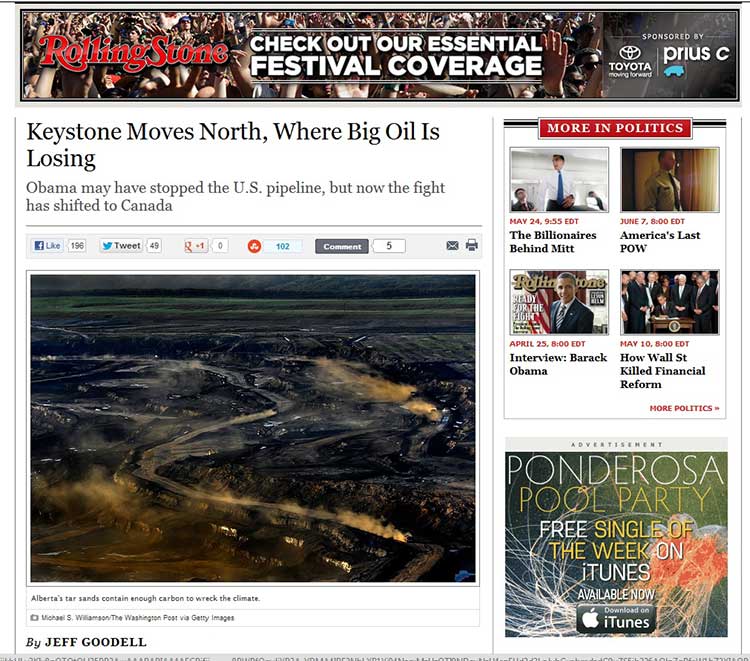Mitt Romney, the Republican candidate for president of the United States today issued his “white paper” on energy policy. It calls for an integrated energy market with Canada, the United States and Mexico. Romney also endorses Prime Minister Stephen Harper’s environmental fast track “one project one review” policy.
The PDF version of The Romney Plan for a Stronger Middle Class Energy Independence is posted on his campaign site.
In the Executive Summary Romney says:
A crucial component of Mitt Romney’s Plan for a Stronger Middle Class is to dramatically increase domestic energy production and partner closely with Canada and Mexico to achieve North American energy independence by 2020. While resident Obama has described his own energy policy as a “hodgepodge,” sent billions of taxpayer dollars to green energy projects run by political cronies, rejected the Keystone XL Pipeline as not in “the national interest,” and sought repeatedly to stall development of America’s domestic resources, Romney’s path forward would establish America as an energy superpower in the 21st century.
It’s key recommendations are:
• Approve the Keystone XL pipeline;
• Establish a regional agreement to facilitate cross-border energy investment,
infrastructure, and sales;• Promote and expand regulatory cooperation between governments to encourage
responsible energy production, including the creation of a forum for sharing best
practices and technologies; and• Institute fast-track regulatory approval processes for cross-border pipelines and other infrastructure.
While the white paper is supposed to be the foundation of Republican energy policy, it is itself a “hodgepdge,” mostly a cut and paste job of various reports in the US and Canadian media. While the paper does cite those many sources, it is the kind of compiliation that would get a university freshman a fail, for lack of original content. It also get the name of Canada’s finance minister wrong in one reference, calling him correctly Jim Flaherty in the headline but “Jay Flaherty” in the story credit.
Romney’s paper also seems to be worried that the fact from the prime minister, many economists and policy analysts are saying that it is imperative that Canada diversify its market away from the United States.
Some key highlights of Romney’s white paper of quotes includes:
Obama’s Rejection Of Keystone Will Force Canada To Ship Its Vast Supplies Of Oil To China. “Ronald Liepert, the energy minister in Alberta, said that while Canada would prefer to sell its oil to the United States, ‘this commodity will go someplace.’ In particular, he said, China is already a major consumer of other Canadian natural resources and a small investor in the oil sands. ‘I can predict confidently that at some point China will take every drop of oil Canada can produce.’” (Ian Austen, “Oil Sands Project in Canada Will Go On If Pipeline Is Blocked,” The New York Times, 6/6/11)
Romney then quotes SunMedia:
Canadian PM Harper: “Look, the very fact that a ‘no’ could even be said underscores to our country that we must diversify our energy export markets…We cannot be, as a country, in a situation where our one and, in many cases, only energy partner could say no to our energy products. We just cannot be in that position.” (Bryn Weese, “Harper Determined To Get Canadian Oil To Asia,” Sun News, 4/3/12)
So while Romney wants to approve the Keystone XL pipeline, there is no mention of the Northern Gateway project, but it is clear they don’t want bitumen oil going outside of the continent.
However, the Republicans seem to like quoting Harper’s fast track approach which has caused an uproar here in Canada, quoting the Wall Street Journal:
Compare The Canadian Approach: “One Project, One Review.” “The budget also treats Canada’s energy resources as national assets to be exploited—with as few delays as possible. Thus the budget proposes to eliminate overlapping federal and provincial environmental reviews for major projects. It proposes firm review timelines, including for projects that are already underway, such as the Northern Gateway pipeline from northern Alberta to the Pacific coast. Mr. Flaherty’s catch phrase is ‘one project, one review.’” (Editorial, “Canada Beats America,” The Wall Street Journal, 4/3/12)
and also appearing to endorse downloading to the provinces (or in the case of the US, the states), while warning Americans about Finance Minister Jim Flaherty’s statement in the Commons about diversifying Canada’s markets.
Compare The Canadian Approach: “Respect Provincial Jurisdiction … Streamline The
Review Process.” CANADIAN FINANCE MINISTER JIM FLAHERTY: “Canada’s resource industries offer huge potential to create even more jobs and growth, now and over the next generation. This potential exists in every region of the country–natural gas in British Columbia, oil and minerals on the Prairies, the Ring of Fire in Ontario, Plan Nord in Quebec, hydro power in Atlantic Canada, and mining in Canada’s North. Recently it has become clear that we must develop new export markets for
Canada’s energy and natural resources, to reduce our dependence on markets in the United States.
The booming economies of the Asia- Pacific region are a huge and increasing source of demand, but Canada is not the only country to which they can turn. If we fail to act now, this historic window of opportunity will close. We will implement responsible resource development and smart regulation for major economic projects, respecting provincial jurisdiction and maintaining the highest standards of environmental protection. We will streamline the review process for such projects, according to the following principle: one project, one review, completed in a clearly defined time period. We will ensure that Canada has the infrastructure we need to move our exports to new markets.” (Canadian Finance Minister Jay Flaherty, The House Of Commons, Remarks, 3/29/12)
One has to wonder if Mitt Romney’s other policies are also cut and paste jobs and, if elected, how often he will be calling Stephen Harper for advice.


